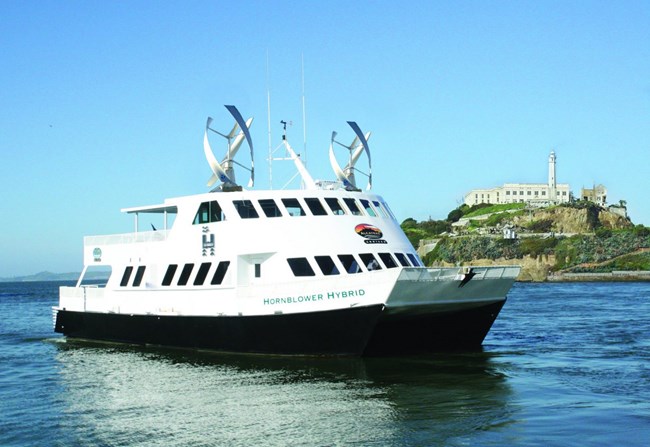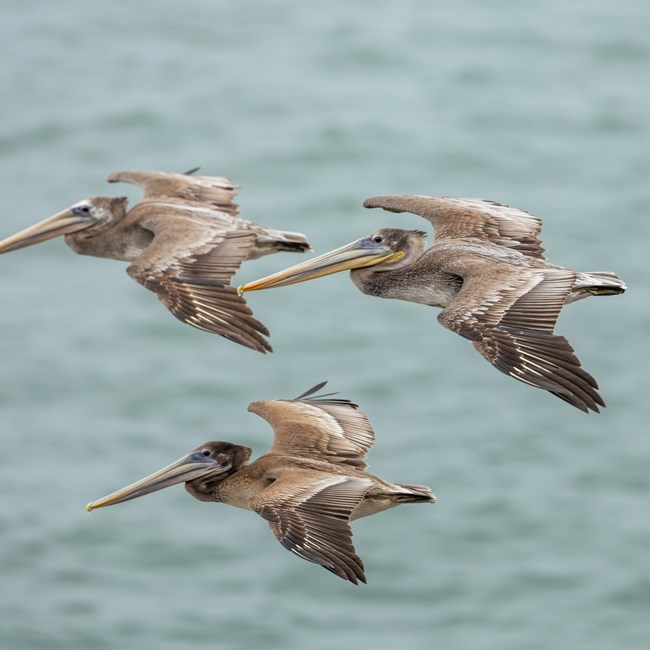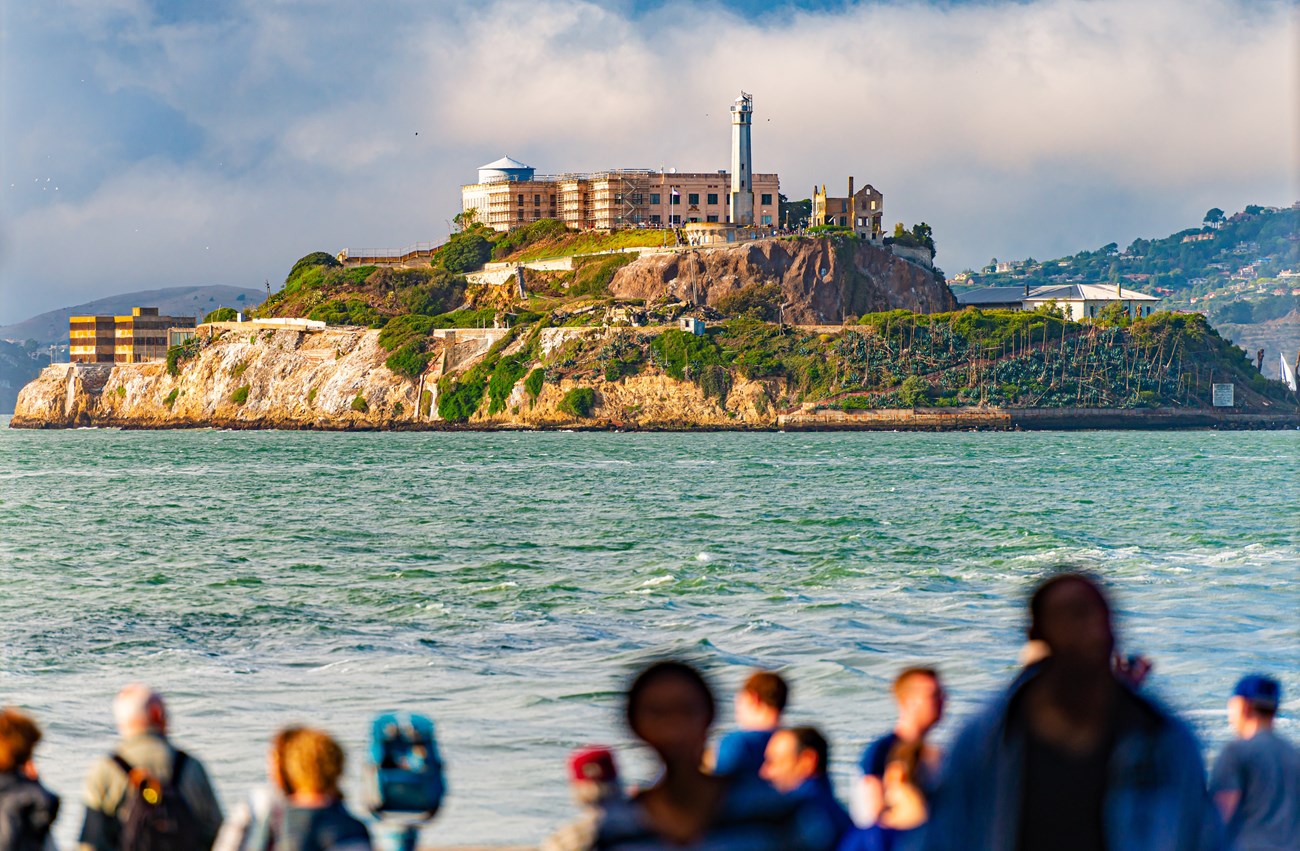Last updated: May 8, 2024
Article
Case Study: Hybrid Ferries to Alcatraz
How can innovation help us meet our sustainability goals? Park staff at Golden Gate National Recreation Area partner with Alcatraz City Cruises to meet unprecedented problems with unprecedented solutions. They’ve pushed to be on the cutting edge of sustainable technology by investing in the nation’s first hybrid-electric passenger ferries.

Photo courtesy of Alcatraz City Cruises
More than a million people visit Alcatraz Island each year. Visitors take the ferry from the San Francisco pier to experience the island’s long history, spanning from pelican rock, to prison, to modern-day museum. It’s a place to reflect on how people have treated nature and each other in the past, and how we might want to do so in the future.
But like the rest of Golden Gate National Recreation Area, the country, and the world, the future of Alcatraz isn’t certain. Climate change impacts like sea level rise and extreme storms change the island, and make things less safe for people and wildlife. Weather changes have been getting more extreme, with winter storms and intense wildfire seasons bringing climate change to the top of peoples’ minds more than ever before.
Staff at Golden Gate National Recreation Area have been working on climate change for a long time. They’ve been committed to taking a leadership role on climate action by reducing the park’s carbon footprint. Doing so has required the courage to try solutions that no one has done before—and it’s paid off. In 2018, Golden Gate became the first National Park System unit to achieve carbon-neutral operations.
But they haven’t been doing it alone. Sustainable operations can’t happen unless concessioner companies are also on board. So, the park has partnered with organizations that are also committed to climate action, like Alcatraz City Cruises.
Laying the groundwork
In 2006, the contract for a concessioner to run passenger ferries to and from Alcatraz was up for grabs. But the park wasn’t just looking for a company that could operate the boats—they also were looking for someone that could match their commitment to sustainability. Alcatraz City Cruises (ACC) was a great fit.
After all, ACC had already been working on reducing their carbon footprint. Terry MacRae, the owner of ACC at the time, was focused on sustainability and saw the new contract as an opportunity to do even more. So, ACC staff set out to try something new to drastically reduce their carbon emissions—creating hybrid passenger ferries. They began work on developing technology that could upgrade diesel-powered boats to water safe hybrid engines.
Forging a new path

Photo courtesy of Alcatraz City Cruises
In 2008, their efforts were rewarded. The country’s first hybrid electric ferry, the Hornblower Hybrid, was unveiled, and began taking passengers to and from Alcatraz on a combination of electric and diesel power. It was followed in 2011 and 2012 by two other upgraded ferries, the Alcatraz Clipper and Alcatraz Flyer.
The boats have electric motors powered by two engine systems, electric and diesel-powered. They run on electric power as much as possible, and use the diesel engine as a backup, much like a hybrid car. And the electric batteries are powerful—the boats can run up to five roundtrips to and from Alcatraz on battery power alone. What’s more, things that use electricity onboard (like lights and speakers) are powered by solar panels and wind turbines on the ships’ roofs.
The process of creating these sustainable engines wasn’t easy, and it wasn’t without complication, as the rollout of any new technology would be. ACC had to train staff in using, maintaining, and repairing the new hybrid systems. There was some trial and error, as they figured out the details of the technology. But over time, the company and staff learned the new systems, and now the boats run smoothly.
Seeing benefits

As of 2023, the Hornblower Hybrid has been moved to a different route, but the Alcatraz Clipper and Flyer are still making many trips to Alcatraz each day. Their hybrid engines make a huge difference. Ferries run to and from Alcatraz 26 times a day, seven days a week. So any reduction in emissions, costs, and pollution adds up quickly.
Because of the two boats’ hybrid engines, ACC uses 235,292 fewer gallons of fuel every year. That’s huge! The emissions from that amount of fuel are the equivalent of a gas-powered car driving more than six million miles. So, by saving that fuel, they’re saving all those emissions. They're also saving money in fuel costs, and releasing less pollution into the air and water.
Plus, the boats are a lot quieter than their diesel-powered counterparts. Quieter engines make for safer working environments for maintenance staff who have to go into the engine rooms. And less engine noise makes for a better riding experience for passengers, especially on longer, narrated boat tours.
With all these benefits, the hybrid-electric ferries are doing a lot to keep the whole ecosystem healthy. Cleaner water and air help animals and plants stay alive and resilient. Less noise pollution helps wildlife follow their natural rhythms. And reducing greenhouse gas emissions helps us work toward a brighter future for all.

Looking to the future
When the first hybrid ferry was made, there were no other boats in the country using the same technology. But, following its example, there are now many other sustainable ferries making a difference in their local ecosystems. Companies around the country—from New York to Seattle—are using the hybrid technology. And some have taken the example even further to create fully electric or net zero ferries.
ACC hasn’t stopped pushing the technology further on the boats they have. In 2020, they upgraded the electric engines’ batteries to more efficient lithium-ion batteries. They’ve also updated the diesel engines to newer, less polluting versions, and started using renewable diesel fuel.
And they’re not done. ACC staff are working with the city of San Francisco to install fast electric chargers on the ferry docks. When the chargers are installed, the boats will be able to charge between every trip and run exclusively on battery power.
But one of the most powerful things about the ferries’ sustainable technology is the number of people they can inspire. More than a million people ride the ferries to Alcatraz each year. For those lucky enough to catch the Clipper or Flyer, there are opportunities everywhere to learn about sustainable technology. Learning about ACC and Golden Gate’s dedication to sustainability could inspire them to take similar action in their own communities, making even more of a difference down the line.
Staff at Alcatraz City Cruises and Golden Gate National Recreation Area were dedicated to their vision, and their hard work paid off. The hybrid boats set an inspiring example that can encourage others to find new ways we can rise to the challenge of climate change—and set sail toward a hopeful future.
Alcatraz City Cruises. n.d. Respect Our Planet. https://www.cityexperiences.com/san-francisco/city-cruises/alcatraz/respect-our-planet/.
Golden Gate National Recreation Area. Updated 2022. Becoming a Carbon Neutral Park. https://www.nps.gov/goga/learn/nature/carbon-neutral-park.htm.
Palmer, Ryan, interview by Claire Baker. 2023. (December 4).
United States Energy Information Administration. 2023. Carbon Dioxide Emissions Coefficients By Fuel. https://www.eia.gov/environment/emissions/co2_vol_mass.php
United States Environmental Protection Agency. 2023. Greenhouse Gas Equivalencies Calculator. https://www.epa.gov/energy/greenhouse-gas-equivalencies-calculator.
Thanks to Ryan Palmer at Alcatraz City Cruises and Laura Castellini at Golden Gate National Recreation Area for providing information for this article.
